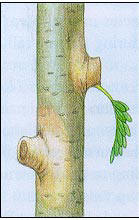Drop Crotch Cuts:
A drop crotch cut removes the upper portion of a tree trunk or limb. Figure 26 shows the drop crotch cutting method for a larger limb or tree trunk.
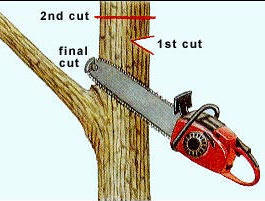
Figure 26 - Drop crotch pruning method
When pruning, using drop crotch cuts, it is not uncommon to have a great deal of epicormic stems on the limb that is directly below the cut. To limit the amount of epircormic growth, avoid making the cut above limbs that are less than 1/3 of the diameter of the limb that is being removed.
As the weight of this piece of tree is usually heavy the following three steps for removal should be used to ensure that little damage is done to the limb or trunk that remains.
- A notch is made above the limb, approximately 1 foot above the limb crotch, that will remain on the opposite side to the limb.
- The second cut removes the top of the limb above the notch made in step 1. This removes the weight of the upper limb and leaves a stub. Cut from the limb side to the notch side, as this will prevent any bark from tearing.
- Remove the stub by cutting horizontally just above the branch bark ridge.
Harmful Pruning Practices:
There are times and situations for every style of pruning techniques and methods. However, there are a few practices that should be avoided unless their are no reasonable alternatives.
- Topping:
- Tipping:
Topping, as shown in Figure 27, is a pruning method whereby large vertical limbs are cutoff between tree trunk nodes in order to reduce the height of the tree.
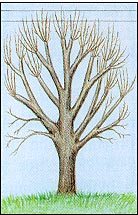
Figure 27 - Topping a tree
Tipping, as shown in Figure 28, is used to decrease the width of a tree's canopy by cutting horizontal limbs between limb nodes.
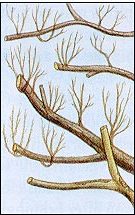
Figure 28 - Tipping a tree
If it is necessary to cut the height or overall size of a tree's canopy then it is much safer, for the tree, to use crown reduction pruning methods.
Pruning methods such as topping and tipping inevitably lead to the growth of epicormic stems and in many cases the piece of limb left in place will die back to the last horizontal limb. The epicormic stems will be growing on a limb that is decaying and if the weight is enough will bring the decayed limb to the ground.
Incorrect pruning, the use of dull pruning tools and improper techniques will result in damage to the tree due to the ripping of bark, as shown in Figure 29.
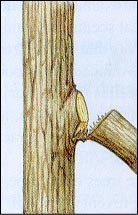
Figure 29 - Bark ripping
Pruning flush against tree trunks and limbs can result in areas of decay, as shown in Figure 30.
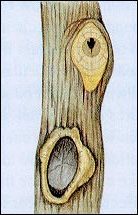
Figure 30 - Flush cutting
Leaving tree limbs as stubs gives access to canker fungi that prevent the proper formation of woundwood, as shown in Figure 31.
